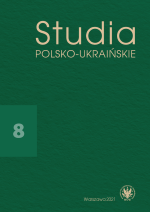Народні балади Волині й Західного Полісся в записах Лесі Українки та членів її родини: українсько-польські паралелі
Folk ballads of Volyn and Western Polissya in the records of Lesya Ukrainka and her family members: Ukrainian-Polish parallels
Author(s): Larysa Semeniuk, Tetiana Danyliuk-TereshchukSubject(s): Language and Literature Studies, Studies of Literature, Ukrainian Literature
Published by: Wydział Lingwistyki Stosowanej Uniwersytetu Warszawskiego
Keywords: Lesya Ukrainka; the Kosach family; Volyn; Western Polissia; folk ballad; version; plot; Ukrainian-Polish borderland;
Summary/Abstract: The article highlights research findings of the ballad plots from the folklore repertoire of Volyn and Western Polissia of the end of the 19th century revealed in the records of Lesya Ukrainka and her family members (Mykhailo and Olha Kosach, Olena Pchilka) and also known in close Polish analogues of those days. The ballads, recorded by the Kosachs, are dominated by stories of family relationships and conflicts caused by marriage without love, long-term separation (the topic of incest), and the mother’s interference in a marital relationship that leads to murder, poisoning, and other tragic situations. A comparative analysis of ballad variants in two languages allows identifying not only the geographical area of spreading of ballad plots in the folklore of neighbouring nations, the specifics of plots, motifs, images, but also points to the features of the Ukrainian and Polish folklore works interaction on the borderlands. In the ballads, belonging to the International Ballad Fund, the plot-lines about wanderings of a dishonoured girl, the incest-related topics, mother’s poisoning of her daughter-in-law and son, about the death of a servant because of his/her mistress’ caprices, the wife’s murder of her husband are typical and similar to various languages. Ukrainian and Polish versions of the ballad-songs have similar features in the structural components of the lyrics, describing mostly life tragic collisions, everyday situations, dialogues of the characters, and artistic details. Despite the affi nity of plots, images, artistic means of expression, multilingual texts off er diff erent, oft en radically diff erent ways of resolving personal and family confl icts. In addition, they are oft en marked with national colouration and refl ect the features of local life, the social life realities of the Ukrainians, Poles, and other ethnic groups. Th e study has revealed that national attribution of the characters, their specifi c national names (especially in the Polish texts), polarization on the principle of ours/a stranger, a native/foreigner are the most noticeable features. Th e Ukrainian and Polish plots express mental ethnic stereotypes of folklore carriers, in particular, regarding women’s role in family and society.
Journal: Studia Polsko-Ukraińskie
- Issue Year: 2021
- Issue No: 8
- Page Range: 40-57
- Page Count: 19
- Language: Polish

